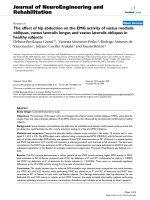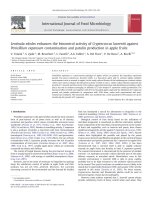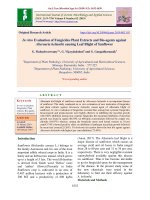Antagonistic activity of biocontrol agents against Rhizoctonia Bataticola causing dry root rot (DRR) in chickpea
Bạn đang xem bản rút gọn của tài liệu. Xem và tải ngay bản đầy đủ của tài liệu tại đây (160.59 KB, 5 trang )
Int.J.Curr.Microbiol.App.Sci (2019) 8(2): 1591-1595
International Journal of Current Microbiology and Applied Sciences
ISSN: 2319-7706 Volume 8 Number 02 (2019)
Journal homepage:
Original Research Article
/>
Antagonistic Activity of Biocontrol Agents against Rhizoctonia bataticola
causing Dry Root Rot (DRR) in Chickpea
Veenashri Jainapur*, Shalini N. Huilgol, S.M. Vastrad and R.B. Jolli
Department of Plant Pathology, College of Agriculture (University of Agricultural Sciences,
Dharwad), Vijayapura-586101, India
*Corresponding author
ABSTRACT
Keywords
Biocontrol agents,
Trichiderma
harzianum, Dual
culture technique,
Paper Towel
method
Article Info
Accepted:
12 January 2019
Available Online:
10 February 2019
Among the four bioagents evaluated for their efficacy in inhibiting mycelial growth of
Rhizoctonia bataticola causing dry root rot of chickpea by dual culture technique. The
results indicated that T. harzianum is highly antagonistic to Rhizoctonia bataticola by
suppressing its growth by 78.67 per cent. Paper towel method was also followed to test the
efficacy of bioagents in suppressing the seedborne infections. Among the four bio-agents
with three concentrations viz., 0.4 %, 0.8 % and 1.2 % tested, as the concentration
increased the percent seed infection was reduced, percent germination and vigour index
were increased. The Trichiderma harzianum with the concentration of 1.2 % has shown
the best result. Seed treatment with Trichoderma harzianum showed least mean seed
infection (13.73 %), higher mean per cent germination (78.03 %) and high mean vigour
index (1461.47).
Introduction
Control of seed-borne plant pathogens by
application of fungicides often gives viable
success despite the high cost involvement and
risks with toxicity of fungicides. Hence, there
is a need to search for alternative methods of
control.
Biological
control
through
introduction of microorganisms antagonistic
to plant pathogens is one of the important
strategy in the management of seed-borne
plant pathogens. In the present investigation,
studies were conducted to know the
antagonistic activity of four bio-agents
namely
Trichoderma
harzianum,
Trichoderma
viride,
fluorescens and Bacillus
Rhizoctonia bataticola.
Pseudomonas
subtilis on
Materials and Methods
In vitro evaluation of bio-agent
The antagonistic micro-organisms i.e.
biocontrol
agents
like
Trichoderma
harzianum Rifai., Trichoderma viride Pers.,
Pseudomonas fluorescens Migula. and
Bacillus subtilis Cohn. were evaluated for
their antagonistic effect under in vitro
condition against Rhizoctonia bataticola by
1591
Int.J.Curr.Microbiol.App.Sci (2019) 8(2): 1591-1595
dual culture technique. They were also tested
for their efficacy in overcoming the seedborne fungal infections in rolled towel
method at 0.4, 0.8 and 1.2 per cent
concentration.
In vitro evaluation of bio-agent by dual
culture technique
In dual culture, twenty ml of sterilized and
cooled potato dextrose agar was poured in to
sterile Petri plates and allowed to solidify.
Fungal bioagents were evaluated by
inoculating the pathogen at one side of Petri
plate and the antagonist inoculated at exactly
opposite side of the same plate by leaving 3-4
cm gap. For this actively growing cultures
were used.
In case of evaluation of bacterial bioagents
two mycelial discs of pathogens were
inoculated and bacterial bioagent was
streaked in the centre of the plate. Each
treatment was replicated five times. After
required period of incubation i.e., after control
plates reached 90 mm diameter, the radial
growth of pathogen was measured. Per cent
inhibition over control was worked out
according to formula given by Vincent
(1947).
In vitro evaluation of bio agent by paper
towel method
The powder formulations of antagonists viz.,
Trichoderma viride, Trichoderma harzianum,
Pseudomonas fluorescens and Bacillus
subtilis were taken for seed treatment to test
their efficacy in overcoming seed borne
fungal infections of chickpea under in vitro
condition by paper towel method. Seeds of
moderately infected chickpea variety JG - 11
were treated with different bio agents at of 0.4
(4 g kg-1), 0.8 (8 g kg-1) and 1.2 (1.2 g kg-1)
per cent concentrations. The seeds were
shaken along with bio agent for 20 minutes in
mechanical shaker for uniform application
and then stored in separate boxes for 24
hours. The treated seeds were tested in 4
replication of 100 seeds by employing rolled
paper towel method. Seeds without treatment
served as control. These paper towels were
incubated at 20 ± 2 ºC for seven days under
12 hrs light and 12 hrs darkness. After seven
days of incubation, per cent germination, per
cent infection was recorded and seedling
vigour index was calculated by taking
seedling length (shoot length + root length) ×
germination percentage (Abdulbaki and
Anderson, 1973).
Results and Discussion
In vitro evaluation of bio-agents by dual
culture technique
The antagonistic micro-organisms like
Trichoderma harzianum, Trichoderma viride,
Pseudomonas fluorescens and Bacillus
subtilis were isolated from the available
market formulations and an attempt was made
to evaluate these four biocontrol agents for
their antagonistic effect against Rhizoctonia
bataticola under in vitro conditions by dual
culture technique. Inhibition zone in mm was
recorded and per cent inhibition was
calculated and the results thus obtained are
presented in Table 1. Among the four
bioagents tested, maximum inhibition of
mycelial growth was noticed in Trichoderma
harzianum (78.67 %) and was found to be
significantly superior to Trichoderma viride
(73.33 %). Least inhibition of mycelial
growth was observed in Bacillus subtilis
(52.22 %) and followed by Pseudomonas
fluorescens (65.11 %).
In vitro evaluation of bio-agents by paper
towel method
An attempt was made to test the efficacy of
four bio-agents, in the management of seed-
1592
Int.J.Curr.Microbiol.App.Sci (2019) 8(2): 1591-1595
borne infection of chickpea variety JG - 11 at
three concentrations viz., 0.4 %, 0.8 % and 1.2
% by employing paper towel method as
explained under ‘Material and Methods’ and
results are presented in Table 2. Among the
four bio-agents tested for their efficacy in the
management of seed-borne infection of
chickpea, seed treatment with Trichoderma
harzianum showed the least per cent seed
infection of 11.20, 13.20, and 16.80 at 1.2,
0.8, and 0.4 per cent concentrations
respectively, followed by Trichoderma viride
with 20.40, 24.80 and 30.00 at 1.2, 0.8 and
0.4 per cent concentrations respectively. And
Relatively more per cent seed infection was
noticed in Bacillus subtilis with 38.00, 42.80
and 46.80 at 1.2, 0.8 and 0.4 per cent
concentrations respectively, followed by
Pseudomonas fluorescens with 30.00, 34.80
and 36.40 at 1.2, 0.8 and 0.4 per cent
concentrations
respectively.
Hence
Trichoderma harianum was found superior
over other treatments in reducing the per cent
seed infection.
Seed treatment with Trichoderma harzianum
showed the highest per cent seed germination
with 84.40, 77.20 and 72.50 at 1.2, 0.8, and
0.4 per cent concentrations respectively,
followed by Trichoderma viride with 81.20,
74.40 and 67.80 at 1.2, 0.8 and 0.4 per cent
concentrations respectively. Least per cent
seed germination was noticed in Bacillus
subtilis with 71.20, 66.40 and 62.80 at 1.2, 0.8
and 0.4 per cent concentrations respectively,
followed by Pseudomonas fluorescens with
78.40, 72.00 and 65.60 at 1.2, 0.8 and 0.4 per
cent concentrations respectively. Hence
Trichoderma harzianum was found superior
over other treatments in increasing the per
cent seed germination.
Seed treatment with Trichoderma harzianum
showed the highest seedling vigour index
with 1656.49, 1412.58 and 1315.35 at 1.2,
0.8, and 0.4 per cent concentrations
respectively, followed by Trichoderma viride
with 1460.73, 1302.92 and 1133.16 at 1.2, 0.8
and 0.4 per cent concentrations respectively.
And least seedling vigour index was noticed
in Bacillus subtilis with 1034.10, 1016.91 and
983.75 at 1.2, 0.8 and 0.4 per cent
concentrations respectively, followed by
Pseudomonas fluorescens with 1197.95,
1165.82 and 1015.11 at 1.2, 0.8 and 0.4 per
cent concentrations respectively.
Table.1 In vitro evaluation of biocontrol agents against R. bataticola
Sl. No.
1
Bioagents
Trichoderma harzianum
2
Trichoderma viride
3
Pseudomonas fluorescens
4
Bacillus subtilis
S. Em. ±
C.D. at 1 %
Per cent inhibition
78.67
(62.49)*
73.33
(58.91)
65.11
(58.80)
52.22
(46.27)
0.29
0.81
*Figures in the parenthesis indicates the angular transformed value
1593
Int.J.Curr.Microbiol.App.Sci (2019) 8(2): 1591-1595
Table.2 In vitro evaluation of bioagents against seed mycoflora of chickpea by Paper towel method
Bioagent (B)
Per cent seed infection
Concentration (C)
0.4 %
0.8 % 1.2 % Mean
Per cent seed germination
Concentration (C)
0.4 % 0.8 % 1.2 % Mean
0.4 %
Vigour index
Concentration (C)
0.8 %
1.2 %
Mean
Trichoderma harzianum
16.80
13.20
11.20
13.73
72.50
77.20
84.40
78.03 1315.35 1412.58 1656.49 1461.47
(24.20)* (21.30) (19.55) (21.75) (58.37) (61.48) (66.74) (62.05)
Trichoderma viride
30.00
(33.21)
36.40
(37.11)
46.80
(43.17)
50.60
(45.34)
36.12
(36.58)
(B)
0.56
1.62
Pseudomonas fluorescens
Bacillus subtilis
Control
Mean
S. Em. ±
C.D. at 1 %
24.80
(29.87)
34.80
(36.15)
42.80
(40.86)
53.26
(46.87)
33.24
(34.68)
(C)
0.43
1.26
20.40
25.05
(26.85) (29.97)
30.00
33.73
(33.21) (35.49)
38.00
42.53
(38.06) (40.69)
56.17
53.34
(48.54) (46.92)
30.04
(32.60)
BXC
0.97
2.81
67.80
(55.43)
65.60
(54.09)
62.80
(52.42)
61.20
(51.47)
63.52
(52.85)
(B)
0.51
1.48
*Figures in the parenthesis indicates the angular transformed values
1594
74.40
(59.60)
72.00
(58.05)
66.40
(54.57)
62.45
(52.51)
70.24
(57.06)
(C)
0.40
1.15
81.20
74.47 1133.16 1302.92 1460.73 1298.93
(64.30) (59.65)
78.40
72.00 1015.11 1165.82 1197.95 1126.29
(62.31) (58.05)
71.20
66.80
983.75 1016.91 1034.10 1011.58
(57.54) (54.82)
65.40
63.02
725.56 755.06 785.06 755.22
(53.97) (52.54)
75.28
1047.11 1130.01 1214.91
(60.47)
BXC
(B)
(C)
BXC
0.89
6.87
5.32
11.89
2.57
19.83
15.36
34.35
Int.J.Curr.Microbiol.App.Sci (2019) 8(2): 1591-1595
Seed treatment with Trichoderma harzianum
has shown superiority over other bioagents,
within
the
Trichoderma
harzianum
concentrations the 1.2 % has shown the best
results. Seed treatment with Trichoderma
harzianum shown least mean seed infection
(13.73 %), higher mean per cent germination
(78.03 %) and mean high vigour index
(1461.47). followed by Trichoderma viride
per cent mean seed infection(25.06), per cent
mean seed of germination (74.47) and
seedling vigour index(1298.93). Seed
treatment with Bacillus subtilis was found
ineffective, with highest 42.53 per cent mean
seed infection, with least 66.80 per cent mean
germination and 1011.58 vigour index
followed
by
Seed
treatment
with
Pseudomonas fluorescens with 33.37 per cent
mean seed infection, with least 72.00 per cent
mean germination and 1126.29 vigour index.
The present findings are in agreement with,
Choudhary et al., (2010) tested four bioagents
viz., Trichoderma viride, Trichoderma
harzianum, Aspergillus versicolor and
Bacillus firmus for the control of dry root rot
in mungbean. In dual cultures, Trichoderma
viride,
Trichoderma
harzianum
and
Aspergillus versicolor were effective in
inhibiting the growth of Macrophomina
phaseolina to an extent of 61 to 65%.
Similarly Khan and Khan (2015) studied the
seed treatment with bio-fungicides for
management of dry root rot of Chick pea
caused by Macrophomina phaseolina. Seed
treatment with bio-wilt X (Trichoderma
harzianum) reduced the severity to 2.4 on 0-5
scale followed by bio-derma (T. viride, 2.7)
and Abtec Pseudo (Pseudomonas fluorescens,
2.8). The functional nodule count decreased
while an increase in non functional nodules
was recorded due to inoculation with
Macrophomina phaseolina.
References
Abdualbaki, A. A. and Anderson, J. P., 1973,
Vigour determination in soybean seeds
by multiple criteria. J.Crop sci., 13:
630-633.
Choudhary, S., Pareek, S. and Saxena J.,
2010, Efficacy of biocontrol agents
singly and in combinations against dry
root rot (Macrophomina phaseolina) of
mungbean. J. of Mycol. and Pl.Pathol.,
40 (1):141-144.
Khan, U. and Khan, M. R., 2015, Seed
treatment with bio-fungicides for
management of dry root rot of Chick
pea
caused
by
Macrophomina
phaseolina. Department of Plant
Protection, Faculty of Agricultural
Sciences, Aligarh Muslim University,
Aligarh 202 002, India.
Vincent, J. M., 1947, Distortion of fungal
hyphae in the presence of certain
inhibitors. J. Nat., 159: 850.
How to cite this article:
Veenashri Jainapur, Shalini N. Huilgol, S.M. Vastrad and Jolli, R.B. 2019. Antagonistic
Activity of Biocontrol Agents against Rhizoctonia bataticola causing Dry Root Rot (DRR) in
Chickpea. Int.J.Curr.Microbiol.App.Sci. 8(02): 1591-1595.
doi: />
1595









